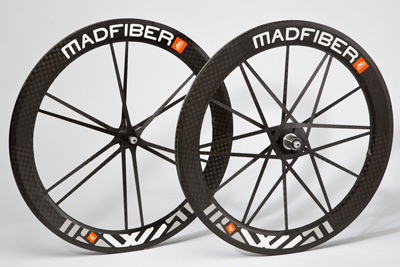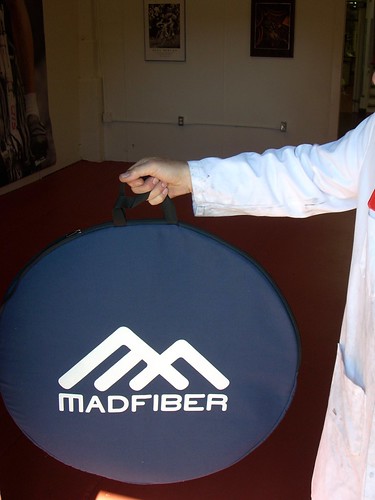Mad Fiber has been making waves in the wheel market of late. They showed up a the Amgen Tour of California to show off their new offering and a buzz has been following them ever since. I got a chance to spend the better part of an hour with Ric Hjertberg (the technologist) and Russ Riggins (the business guy) talking about what they have cooking in the vacated bakery space in Seattle’s Fremont neighborhood.

At the center of this new product is a new approach. Traditionally, wheels have experienced a slow evolution as companies have targeted parts of the wheel to replace with better/faster/lighter materials. From Wood, to Steel, to Aluminum, to Carbon (and many others tucked in there), wheels have made incremental improvements as updates were made to the spoke, the rim, or the hub. Ric’s idea was that this piecemeal view is flawed. Instead he approached the wheel as an engineer and came up with: “What are loads and properties we are trying to solve for.” He and his team looked at the physics involved from point of view of an scientist and not a cyclist and arrived at the Mad Fiber wheel (the lead engineer is an aerospace guy – not a cycling guy). It’s not a carbon rim with carbon spokes and a carbon hub (which is already out there). Instead it’s a bonded, unified object that supports the tire, and from there distributes the load not just through traditional spokes, but across the wheel edge and the entire “system”. Of course they were constrained by some regulations specified by the UCI (e.g. 1cm spoke width max). What resulted was a complete wheel that is stronger than any other on the market against a static load, while weighing in at a hair over 1000g.
So what’s the catch? The wheels go on sale today on their website and they are ready to start filling orders in a few weeks, but you can’t line up at the start of a UCI event just yet. The UCI requires a minimum number of spokes, and the tests to failure have to display certain characteristics. The somewhat mysterious wheel approval test still has to be passed, but given the fact that the wheel has outlasted the static load test device (700lbs load) they are hopeful. Then there’s the question they get the most, “What happens if I break a spoke or the wheels goes out of true?”. Their response is that if you break the wheel…then you probably drove over it with a car and it’s time to talk about a crash replacement program. There are no nipples or threads to tighten, so if something is damaged to the point where the wheel balance is impacted…the wheel is done.
What struck me as being really cool about the Mad Fiber idea is that this is truly a Seattle company. “Mad” actually is a reference to the Madison Park area. Every aspect of the build is handled right here in Seattle:
- tooling created
- wheels cut and assembled
- graphics designed and cut
- anodizing
Even the wheel bags that come with every set are made over in Byron’s neighborhood – West Seattle. The only exception is the hub assembly which comes from NorCal and White Industries.
Since I’m a bike commuter in addition to a racer, I asked about some future options: Disc brakes for cross? Clincher tires? Mountain bike Wheels? Rim width options? Of course they have thought about all of these things, but they are focused on the task at hand – get to market with their initial wheel offering. Their tooling is architected in such a way that shifting gears to support these new configurations will not require a complete rebuild.
Lastly – where can you try them out? Mad Fiber is distributing directly through their website, but they are building a network of Local Bike Shops to keep a demo pair on hand to test out. Their thought is that the ride of the wheel will speak for itself and drive plenty of interest. Based on what I’ve seen I’m pretty sure they are right.
Keep up with MadFiber on Twitter and Facebook
…We're riding townies, adventure, and mountain bikes. Find recommendations on our store page. As Amazon Associates we earn from qualifying purchases.
